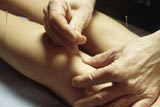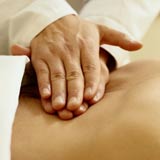Acupuncture and Tunia
Acupuncture
Acupuncture has a well documented history spanning more than 2,000 years, and is still one of the most commonly used medical procedures in the world today. Acupuncture has been promoted by the World Health Organization to treat many illnesses and disorders. The National Institute of Health (NIH) Consensus Conference on Acupuncture in 1997 stated, "The data in support of acupuncture are as strong as those for many accepted Western medical therapies. One of the advantages of acupuncture is that the incidence of adverse effects is substantially lower than that of many drugs and other accepted medical procedures used for the same conditions."
To treat a patient, the acupuncturist uses hair-thin needles to stimulate special points on the body. The acupuncture points are chosen based on the appropriate traditional Chinese medicine diagnosis and meridian theory. There are 12 regular meridians and 8 extra meridians running through the whole body, all of which are connected by many minor connecting meridians to form a web of continuous channels enabling Qi (vital energy) and blood to circulate. According to traditional Chinese medical theory, illness and pain arise when there is
- - An external pathogen invading the body
- - An imbalance of Yin, Yang, Qi and blood, or
- - Blockage of Qi and/or blood circulation
Acupuncture stimulation of certain points can eradicate pathogens, balance Yin, Yang, Qi, and blood, or open up the blockage in a channel, treating both the symptoms and the root of the disease.
Tunia
Tuina is a type of therapeutic massage developed in China more than 2,000 years ago. Tuina is effective for musculoskeletal problems such as sports injuries, neck pain, shoulder tension, lower back pain, and numbness and tingling in the limbs. Tuina is also good for relieving headaches, stress, anxiety, depression, and insomnia. Unlike many modern drug-based or surgery-based treatments, Tuina has minimal side effects.
Tuina's techniques range from light stroking to deep-tissue work. This includes the use of hand techniques to massage soft tissues (muscles and tendons), as well as stretching, acupressure, and other techniques to realign musculoskeletal relationships, relax muscle spasm, mobilize joints, and reduce inflammation. Herbal ointments or liniments can also be used topically to enhance the above therapeutic methods.
Treatment sessions last from 30 minutes to over an hour. Patients should wear loose and comfortable clothes during the session. Patients often return for additional treatments for chronic conditions. In addition to the release of pain, the patient usually feels relaxed, or surprisingly energized, by the treatment.
Tuina is not used for conditions involving compound fractures, external wounds, open sores or lesions, or with infectious conditions such as hepatitis. Tuina should not be performed on the abdominal region of a pregnant woman. Wait at least one hour after eating before entering treatment.





